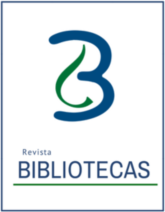The use of ICT in the area of Library and Information Science
Keywords:
Software, Libraries, Education, Internet, Web 2.0Abstract
Information technology and communication (ICT): this area is related to the development of IT skills from a global perspective, includes the use of the computer and managing files, digitized information, spreadsheets, and databases to develop documentary support, hypertext (www), multimedia, library automation, networks and information systems, virtual libraries, supported by telematics.
References
Becker, H. J. (1999) How are Teachers Using Computers in Instruction. Recuperado de http://www.crito.uci.edu/tlc/findings/conferences-pdf/how_are_teachers_using.pdf
Buzan, Tony (2004).Cómo crear mapas mentales: el instrumento clave para desarrollar tus capacidades mentales que cambiará tu vida. Ediciones Urano
Cañas, A. J., Hill, G., Granados, A., Pérez, C., y Pérez, J. D. (2003). The network architecture of cmaptools (IHMC cmaptools technical report 2003-01). Pensacola, FL: Institute for Human and Machine Cognition.
Eduteka (2007).Reseña de organizadores gráficos.Recuperado de http://www.eduteka.org/modulos.php?catx=4&idSubX=86&ida=718&art=1
Gutiérrez, F. (2012) Aplicaciones android esenciales para communitymanager bibliotecarios. Recuperado de http://www.infotecarios.com/aplicaciones-android-esenciales-para-community-manager-bibliotecarios/
Harrilnk, M. (1997). Integrating educational technology into teaching.Prentice Hall, Columbus, Ohio, EEUU.
Jonassen, D.H. (1996). Los computadores como herramientas de la mente. Recuperado de http://www.eduteka.org/tema_mes.php3?TemaID=0012
Marquina J. (2010). La figura del community manager en las bibliotecas.Recuperado de:http://www.julianmarquina.es/figura-community-manager-bibliotecas/
Martínez J. (2012). Portales educativos españoles: revisión y análisis del uso de servicios 2.0. Revista Investigación Bibliotecológica. 26 (58) pp. 47-69.
Novak, J.D. (1998). Learning, creating and using knowledge. Lawrence Erlbaum Associates, Publishers. New Jersey.
Novak, J.D., Cañas, A. J. (2006). The theory underlying concept maps and how to construct them.Pensacola, FL: Institute for Human and Machine Cognition.
O`Reily, T (2005). What it web 2.0 desing patterns and business models for the next generation of software. Recuperado de: http://oreilly.com/web2/archive/what-is-web-20.html
Picardo J., O.(2002). Pedagogía informacional. Edutec. Revista Electrónica de Tecnología Educativa.(15). Recuperado de: http://edutec.rediris.es/Revelec2/Revelec15/oscarpicardo.htm
Reeves, T.C. (1998). The Impact of media and technology in schools: a research report prepared for the bertelsmann foundation.Recuperado de http://caret.iste.org/index.cfm?fuseaction= studySummary&studyid=418
Sandí, M. (2012). Las redes sociales presentes en las bibliotecas. E-Ciencias de la Información. 2 (2).
Villanueva, L. (2006). Motivación y creatividad para la bibliotecología. Buenos Aires, Argentina: Alfagrama.
Downloads
Published
How to Cite
Issue
Section
License
Bibliotecas provide immediate open access to their content, based on the principle of facilitating research to the public free of charge and free of charge to promote the global exchange of knowledge.
The journal Bibliotecas is a publication hosted by a public higher education institution, which is supported by public resources. Since its inception, the magazine has offered all its contents free of charge without any restriction on the rights of: reading, downloading and printing in full text. Works published in libraries may be analyzed, quoted and reproduced in whole or in part, mentioning the original source.
The journal Bibliotecas is licensed under the Creative Commons Attribution - Non-Commercial - Share Equal, 4.0 International license; therefore, it is allowed to: share, copy and redistribute the material in any medium or format.

Este obra está bajo una licencia Creative Commons Atribución-NoComercial-CompartirIgual 4.0 Internacional.








